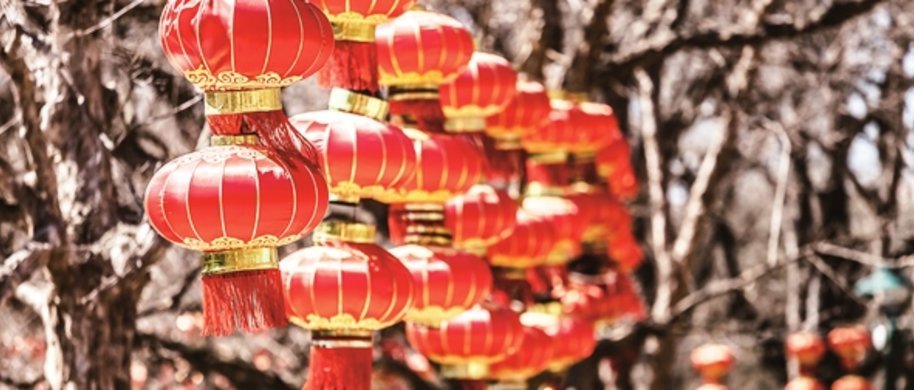
Yunnan's cultural life is one of remarkable diversity. Archaeological findings have unearthed sacred burial structures holding elegant bronzes in Jinning, south of Kunming. In Zhaotong in northeastern Yunnan, fresco of the Jin Dynasty (265–420) have been discovered. Many other Chinese cultural relics have been discovered in later periods. The lineage of tribal way of life of the indigenous peoples persisted uninfluenced by modernity until the mid-20th century. Tribal traditions, such as Yi slaveholding and Wa headhunting, have since been abolished. After the Cultural Revolution (1966–76), when many minority culture and religious practices were suppressed, Yunnan has come to celebrate its cultural diversity and subsequently many local customs and festivals have flourished.
Eighteen Oddities of Yunnan
The Eighteen Oddities of Yunnan are eighteen unique traits of the Yunnan province of southwest China. The oddities, which are as follows, are generally presented in the form of a list, which is promulgated in promotional materials advertising the province to foreign and domestic tourists.
1. Eggs are tied up sold in rope-like clusters
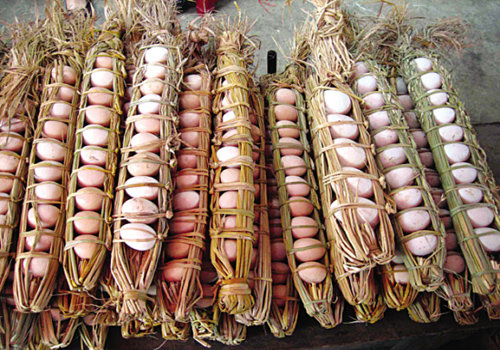
2. Bamboo hats are used as wok lids

3. Three mosquitoes make up a dish - mosquitoes are so large that it is said that just three are large enough to make a meal
4. Bamboo is used to make water pipes and bongs for smoking
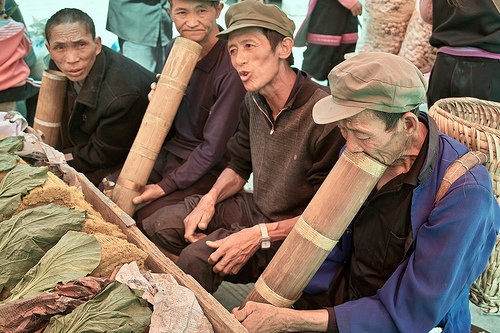
5. Erkuai - a local culinary specialty made of rice, whose name translates literally as "ear piece"
6. The same dress is worn for all four seasons - clothing for all four seasons may be seen on a single day in Yunnan, as climatic conditions may vary widely according to altitude and region
7. Young girls are called "Old Lady"
8. Cars move faster than trains
9. Toes are exposed all year round
10. Rain here but sunshine there - the weather is often variable between areas just a few kilometers apart
11. Girls wear flowers in all four seasons
12. Girls carry tobacco bags
13. Green vegetable is called "bitter vegetable"
14. Grannies climb mountains faster than monkeys
15. Trains go abroad but not inland
16. Monks can have love affairs
17. Children are raised by men - Yunnan women have a reputation for being hard-working, thus many men stay home to take care of their children
18. Cars move in the clouds - many roads are high in the mountains
More about the 18 oddities, its background and topicality can be found here.
Cuisine
Yunnan cuisine is an amalgam of Han Chinese and Chinese minority cuisines. As the province with the largest number of ethnic minorities, Yunnan has a great variety of food, and it is difficult to make generalisations. Many Yunnanese dishes are quite spicy, and mushrooms feature prominently. Another important characteristic of Yunnan cuisine is the wide use of flowers as food. Two of the province's most famous products are the renowned Pu'er Tea which is traditionally grown in Simao; as well as Xuanwei Ham, which is often used to flavour stewed and braised foods in Chinese cuisine, as well as for making the stocks and broths of many Chinese soups.

Famous dishes of Yunnan are listed up below. More details to meals in Yunnan and on our tours can be found here.
-
Guo qiao mi xian ('Crossing the bridge' or 'Across the bridge' noodles), Yunnan's best known dish. Typically consists of a bowl of chicken stock, to which diners add their own selection of paper-thin meat slices, rice noodles (mixian), vegetables and spices, much like a hot pot. Ubiquitous throughout the province.
-
Qi guo ji (Steam pot chicken), chicken steamed with tonic herbs in a special ceramic pot.
-
Boluo fan (Pineapple rice), found in Xishuangbanna and possibly other Dai areas.
-
Yiliang Roast Duck, crispy skin roast duck similar to Peking duck, but honey is used to crisp and colour the skin. It is roasted with pine branches and needles, which imparts a unique flavour on the duck.
-
Jidou liangfen, a savoury jelly made from chickpea flour.
-
Shiping doufu (Shiping tofu)
-
Erkuai (highly refined and compressed rice cakes)
-
Lufu, a type of fermented bean curd, typically used as a condiment or made into sauces. It is reddish yellow in colour, with a soft texture and a savory flavor.
-
Rubing (goat's milk cheese, from Bai cuisine in the area near Dali)
-
Rushan (cow milk cheese)
Tea
One of Yunnan's famous products is Pu'er Tea, named after the old tea trading town of Pu'er in Yunnan's south (Simao Region). The province is also known for its Yunnan Gold and other Dianhong teas, developed in the 20th century.
Pu'er, Pu-erh, Puer, Po Lei or Bolay is a variety of post-fermented tea produced in Yunnan Province, China. Post-fermentation is a tea production style in which the tealeaves undergo a microbial fermentation process after they are dried and rolled. This is a Chinese specialty and is sometimes referred to as dark tea. There are a few different provinces, each with a few regions, producing dark teas of different varieties. Those produced in Yunnan are generally named Pu'er, referring to the name of Pu'er county which used to be a trading post for dark tea during imperial China.
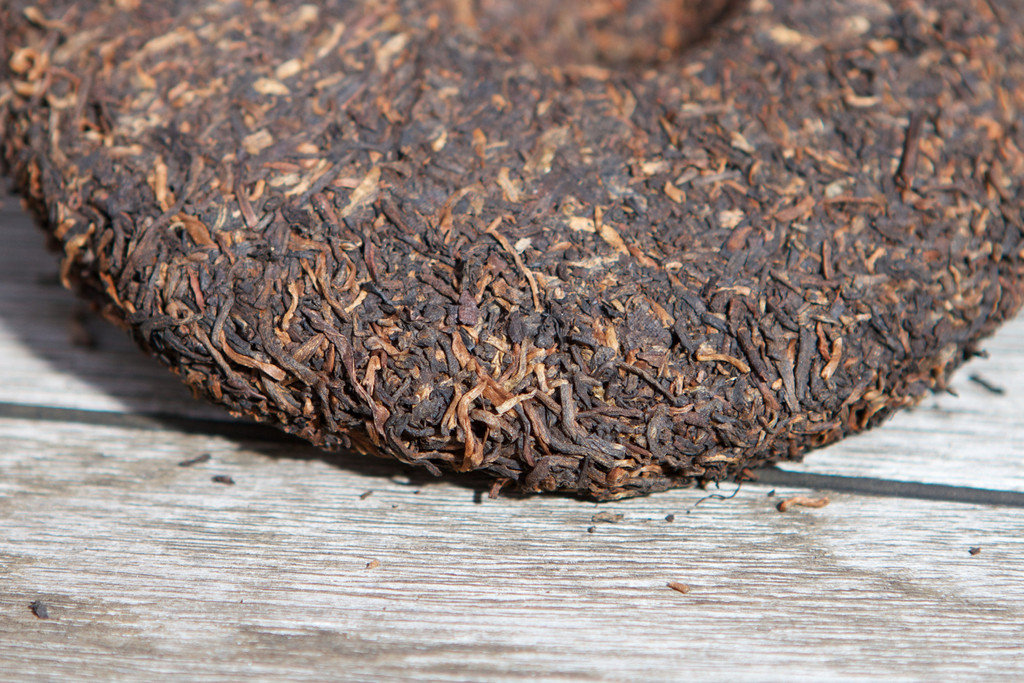
Pu'er is available as loose leaf or in various compressed forms (e.g. tea bricks). There is also the differentiation of raw (sheng) and ripened (shou) types. The shou type refers to those varieties that have gone through a proper post-fermentation process, while the sheng types are those in the process of gradual darkening through exposure to the environmental elements. Certain selections from either type can be stored for maturity before consumption. That is why some are labelled with year and region of production.
Darkening tealeaves to trade with ethnic groups at the borders has a long history in China. These crude teas were of various origins and were meant to be low cost. Darkened tea is still the major beverage for the ethnic groups in the southwestern borders and, till the early 1990s, was the third major tea category produced by China mainly for this market segment.
There had been no standardized processing for the darkening of pu'er tea until the postwar years in the 1950s, where there was a sudden surge in demand in Hong Kong, because of the concentration of refugees from the mainland. In the 1970s, the improved process was taken back to Yunnan for further development, which has resulted in the various production styles today.
In recent decades, it has become more common for the crude tea to be sold as a finished product before it is darkened. This is called sheng cha, or "raw tea". The tealeaves are supposed to be darkened gradually through exposure to environmental elements during storage. The truly post-fermented type has thus been given a relative name, shu cha', or "ripened" tea. Whether sheng cha or shu cha, appropriate selections of pu'er can mature to acquire improved taste.
All types of pu'er tea are created from Maocha, a mostly unoxidized green tea processed from a "large leaf" variety of Camellia sinensis found in the mountains of southern Yunnan. Maocha can undergo ripening for several months prior to being compressed to produce ripened pu'er (also commonly known as cooked pu'er), or be directly compressed to produce raw pu'er.

While unaged and unprocessed, raw pu'er is technically a type of green tea, ripened or aged raw pu'er has occasionally been mistakenly categorised as a subcategory of black tea due to the dark red colour of its leaves and liquor. However, pu'er in both its ripened and aged forms has undergone secondary oxidization and fermentation caused both by organisms growing in the tea and free-radical oxidation, thus making it a unique type of tea.
The post-fermented tea, dark tea, is one of the six classes of tea in China, and pu'er is sometimes classified as a dark tea (defined as post-fermented), something which is resented by some who argue for a separate category for pu'er tea. As of 2008, only the large-leaf variety from Yunnan can be called a pu'er.
Music
The music of Yunnan includes the tradition music of many ethnic groups, including the Miao, Hani and Naxi, the last being the most numerous in the area.
The lusheng is a type of mouth organ used by the Miao of Guizhou for pentatonic antiphonal courtship songs.
The Hani of Honghe are known for a unique kind of choral, micro-tonal rice-transplanting songs.
The Naxi of Lijiang play a type of song and dance suite called baisha xiyue, which was supposedly brought by Kublai Khan in AD 1253 when he conquered the Kingdom of Dali and received help from a Naxi leader named Mailiang. Basha xiyue is performed by orchestras; there are 24 simple, energetic qupai (tunes) in use. Naxi dongjing is an ancient type of music related to southern Chinese forms, and is popular still today. Dongjing uses a type of traditional musical notation called gongchepu. There are traditional Dongjing Operas, such as Song of the Water Dragon, Waves Washing the Sands and The Sheep on the Hill. Dongjing is a type of ritual music, said to have been sung by Taoist monks in the area. It was introduced at least by the 13th century, and is now known only in Yunnan and the distant city of Chengde (Hebei Province) and Chifeng (Inner Mongolia). Dongjing is traditionally performed during the Chinese Lunar New Year. The President of the Dayan Naxi Ancient Music Association, Xuan Ke, has claimed that donjing originated from the religious and imperial music of the Tang and Song dynasties (thus placing its origins between 618 and 1279). This same period saw the developed of ci poetry, which accompanied music led by stringed instruments. By the 1980s, dongjing had mostly died out. It has since been revived, however, and its popularity among the younger generation is rebounding, especially in Chuxiong, Lijiang, Baoshan, Dali and Kunming. The Dayan Naxi Ancient Music Association was formed in 1987 to help revive donjing. Renowned modern performers include Peng Youshan and Lei Hong'an.
As both these styles are quite old, it has led Naxi music to be called a "living fossil" of Chinese music. In addition to donjing and baisha xiyue, a style called huangjing yinyue also has an ancient history in the area, but is no longer played.
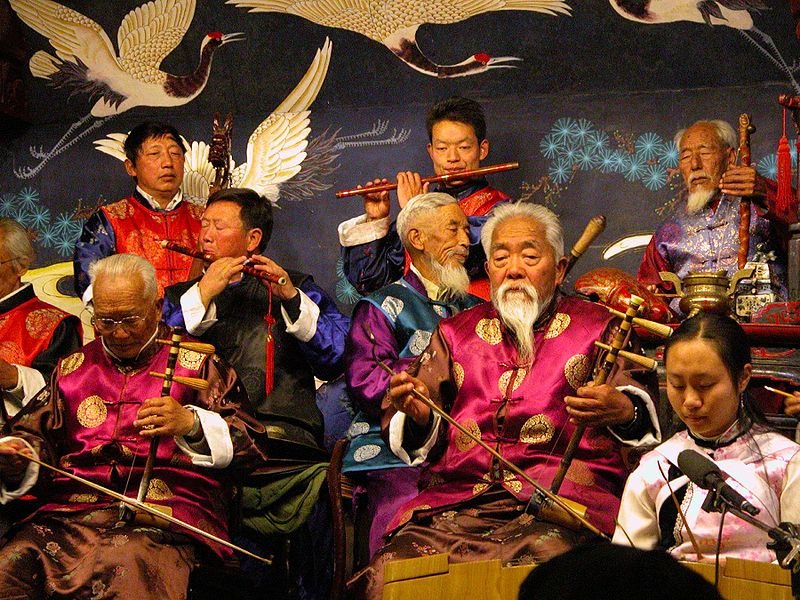
Chinese medicine
Yunnan is host to 15,000 species of plants, including 60 percent of the plants used in traditional Chinese medicine.
Yunnan Baiyao (White medicine from Yunnan) is a hemostatic powdered medicine famous for being carried by the Vietcong to stop bleeding during the Vietnam War. The medicine, developed by Qu Huangzhang in 1902, is designated as one of two Class-1 protected traditional medicines, which gives it 20 years protection. In China, its reputation is equal to that of penicillin in 'western' countries. It is founded and manufactured by a state-owned enterprise, Yunnan Baiyao Group.
The inventor was a Chinese man from Jiangchuan County in Yunnan Province, and had set out to explore the entire region and taste its hundreds of herbs. In 1902 he formulated "Qu Huanzhang Panacea" which became Yunnan Baiyao. In the massive Taierzhuang Battle of 1938 (between Chinese and Japanese forces), Mr. Qu Huanzhang donated more than 30,000 bottles of Yunnan Baiyao to the army, thereby saving the lives of many soldiers. As an indication of its value, it is noted that during the 1940s, army commander Wu Xuexian was seriously injured in his right leg. The French hospital in Kunming recommended amputation to save Wu's life. Mr. Wu turned to Mr. Qu for help, and to everyone's surprise, recovered without the need for an amputation. Yunnan Baiyao gained the reputation as a miracle remedy. After the death of Mr. Qu, his wife, Liao Lanying, donated the secret prescription to the government.
Its main ingredients are Sanqi (Tienchi ginseng, Notoginseng roots of Panax pseudoginseng) - used to normalize blood flow, enhance poor circulation and heal internal bleeding in injuries as well as bleeding ulcers and Rhizoma Dioscoreae. The two tienchi ginsengs are combined with astringent herbs that absorb excess bleeding, invigorate the blood and enhance healing including myrrh and dragon's blood, resinous for internal bleeding.
Its exact formula is a closely guarded secret. The company website mentions that progesterone has been analyzed from the formula, several saponins, alkaloids and the pharmacologically active compound calcium phosphate. However the progesterone may not exist in that state provided that the formula is still the traditional formula since Dioscorea requires laboratory alteration to become progesterone. The separate herbal ingredients are reportedly made up by thirteen separate teams, none of whom have any knowledge of the ingredients the other teams are mixing. The individual mixed components are then combined by a further team, who have no knowledge of what constitutes them but knows the proportions in which they are combined.
Sport
Professional sporting teams in Yunnan include, Yunnan Bulls in the Chinese Basketball Association. Football teams include Yunnan Lijiang Dongba and the defunct Yunnan Hongta. A number of international four wheel drive competitions have been held in the province in the vicinity of Jinggu, Simao. Yunnan is also well known as a destination for cycling, white water rafting, rock climbing and hiking.
- 1439 reads
